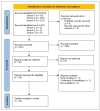Natural Environments in University Campuses and Students' Well-Being
- PMID: 38673325
- PMCID: PMC11050544
- DOI: 10.3390/ijerph21040413
Natural Environments in University Campuses and Students' Well-Being
Abstract
Most recent university campuses follow the North American model, built on city limits or countryside, with large separate buildings in open green spaces. Studies suggest that the prevalence and severity of mental health issues among university students has been increasing over the past decade in most countries. University services were created to face this growing problem, however individual-based interventions have limited effects on mental health and well-being of a large population. Our aim was to verify if and how the natural environment in campuses is focused on programs to cope with the issue of mental health and well-being among students. A systematic review of literature was undertaken with search in Scopus and LILACS with the keywords "green areas" AND "well-being" AND "Campus", following PRISMA guidelines. As a result, 32 articles were selected. Research on the topic is recent, mostly in the USA, Bulgaria, and China. Most studies used objective information on campuses' greenness and/or university students' perception. Mental health was usually measured by validated scores. Findings of all the studies indicated positive association between campus greenery and well-being of students. We conclude that there is a large potential for use of university campuses in programs and as sites for students' restoration and stress relief.
Keywords: greenness; mental health; nature-based solutions; university campus; well-being.
Conflict of interest statement
The authors declare no conflict of interest.
Figures
References
-
- Pinto G., Buffa E. Arquitetura e Educação: Campus Universitários Brasileiros. EdUFSCar; São Carlos, Brazil: 2009.
-
- Lima A.L.G. Educação, Saúde e Progresso: Discursos sobre os efeitos do ambiente no desenvolvimento da criança [1930–1980] Estud. Av. 2023;37:57–70. doi: 10.1590/s0103-4014.2023.37109.005. - DOI
-
- Teixeira A. Jan./Mar Ed: Revista Brasileira de Estudos Pedagógicos. Centro Educacional Carneiro Ribeiro; Salvador, Brazil: 1959. pp. 78–84.
-
- Gulwadi G.B., Mishchenko E.D., Hallowell G., Alves S., Kennedy M. The restorative potential of a university campus: Objective greenness and student perceptions in Turkey and the United States. Landsc. Urban Plan. 2019;187:36–46. doi: 10.1016/j.landurbplan.2019.03.003. - DOI
Publication types
MeSH terms
Grants and funding
LinkOut - more resources
Full Text Sources
Medical
Research Materials
Miscellaneous




